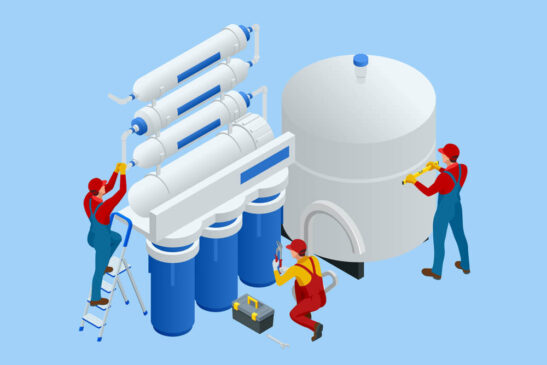Reverse Osmosis Water Filter – Water is an essential resource for human life, and ensuring its quality is crucial for maintaining good health. Reverse osmosis (RO) water filters have gained popularity as a reliable and effective means of purifying drinking water. However, they have positive and negative aspects just like any other technology. In this article, we will explore the pros and cons of reverse osmosis water filter, helping you make an informed decision about whether they are the right choice for your home.
Pros of Reverse Osmosis Water Filters
1. Exceptional Water Purification:
Reverse osmosis is one of the most effective methods of water filtration available. It can remove a wide range of contaminants, including bacteria, viruses, heavy metals, pesticides, chlorine, and dissolved solids. The RO membrane acts as a barrier, allowing only pure water molecules to pass through while blocking impurities, resulting in clean and safe drinking water.
2. Improved Taste & Odor:
The filtration process of reverse osmosis removes unpleasant tastes, odors, and impurities from water, leading to a significant improvement in its overall taste and smell. If you find your tap water has an off-putting taste or smell, an RO system can provide a refreshing change.
3. Convenience & Accessibility:
Having a reverse osmosis water filter system installed at home provides you with convenient access to clean water at any time. You no longer need to rely on purchasing bottled water or worry about the quality of tap water. RO systems can be easily installed under the sink or as a standalone unit, offering hassle-free and readily available purified water.
4. Environmental Benefits:
By choosing an RO system, you contribute to environmental conservation. Unlike bottled water, which creates significant plastic waste, reverse osmosis allows you to reduce your carbon footprint by eliminating the need for single-use plastic bottles. Additionally, RO systems consume less energy compared to other filtration methods, making them an environmentally friendly choice.
Cons of Reverse Osmosis Water Filters
1. Wastewater Production:
One major drawback of reverse osmosis systems is the amount of wastewater they produce during the filtration process. For every gallon of purified water, an RO system can generate three to four gallons of wastewater. This can be a concern in regions where water scarcity is an issue, as it contributes to overall water wastage.
2. Removal of Beneficial Minerals:
While reverse osmosis effectively removes harmful contaminants, it also eliminates essential minerals like calcium, magnesium, and potassium from the water. These minerals are vital for our health, and their absence may lead to mineral deficiencies over time. To address this, some RO systems include remineralization filters or a separate drinking water source for mineral intake.
3. Slow Filtration Process:
Compared to other water filtration methods, reverse osmosis can be relatively slow. The filtration process requires time to push water through the RO membrane, reducing the water flow rate. This might be inconvenient for households that require large quantities of purified water quickly, such as during gatherings or high-demand situations.
4. Upfront & Maintenance Costs:
Investing in a reverse osmosis system can involve a higher upfront cost compared to other water filtration options. The systems typically require professional installation, which adds to the initial expense. Additionally, regular maintenance, such as replacing filters and sanitizing the system, is necessary to ensure optimal performance, adding to the long-term costs.
Conclusion
Reverse osmosis water filters provide exceptional purification, offering clean and great-tasting drinking water in the comfort of your home. While they have undeniable advantages in terms of water quality, convenience, and environmental impact, they also come with certain drawbacks, such as wastewater production, mineral removal, slower filtration, and associated costs.







